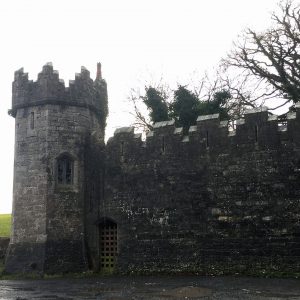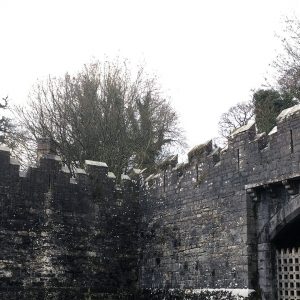Tynan Abbey was a large country house built around 1750 and renovated around 1815. It stood in the village of Tynan, Co. Armagh, and during the Second World War, the extensive grounds housed soldiers from the United States of America and Belgium. Despite many Celtic Crosses scattered throughout the region, there is no evidence that Tynan Abbey was ever an abbey in more than name.
Known areas of the camp included the Gun Yard where the United States Army Artillery stored 105mm artillery guns. Military vehicles would tow these large weapons into place. Across from the Gun Yard was a large open field. Here, American GIs played sports including baseball.
American Forces
The following American forces were based at Tynan Abbey between 1943 and 1944.
| Start Date | End Date | Unit |
|---|---|---|
| 1942 | 3rd Battalion, 133rd Infantry Regiment (34th Infantry Division) | |
| 18th October 1943 | 11th April 1944 | 2nd Battalion, 23rd Infantry Regiment (2nd Infantry Division) |
Descendants of the Stronge family suggest that the owner Sir Norman Stronge and the occupying GIs got along well. Officers and visiting dignitaries stayed in grand abbey house. Troops occupied hundreds of huts that sprawled across the large site. Some of the officers insisted on providing a Willys Jeep to transport the Stronges around the estate.
During the harsh winters in Northern Ireland, many of the American troops struggled with the cold weather. Another family anecdote suggests that the family needed to fence in their coal supplies with barbed wire to prevent the military from acquiring too much. The GIs redeemed themselves however by helping to extinguish a fire that broke out in the house.
U.S. soldiers, by forming a bucket chain with their tin hats, have saved Tynan Abbey, County Armagh, seat of Sir Norman Stronge, Government Chief Whip, from destruction by fire. Woodwork in one of the large windows was set smouldering by a plumber’s blow-lamp. Smelling fire, a U.S. soldier stopped a passing Jeep and sent for help.
A party of U.S. soldiers hurried up with an officer, formed a bucket chain up the stairs, and, using their tin hats for buckets, were just able to get the fire out in time. Another five minutes, the officer said, and it would have been beyond their control.
Belfast Telegraph – Monday 25th October 1943.
A Letter From Ulster
Film director Brian Desmond Hurst used Tynan Abbey as one of the settings for his movie ‘A Letter From Ulster’ in 1942. One memorable scene shows GIs borrowing the Stronge family piano for their entertainment.
Belgian Forces
The following Belgian forces were based at Tynan Abbey in 1945.
| Start Date | End Date | Unit |
|---|---|---|
| 4th June 1945 | 3rd Battalion, 5th (Merckem) Infantry Brigade |
Although much of the site has gone over the years, some structures dating back to the Second World War remain at the site of the former Tynan Abbey. These include American Quonset Huts, British Nissen Huts, a water tower, and signage for American and Belgian forces. Aerial photos also reveal the bases of many huts that would have occupied the site in wartime.
The Provisional Irish Republican Army murdered Sir Norman Stronge and his son Sir James Stronge at Tynan Abbey on 21st January 1981. They then detonated incendiary devices leaving the building in ruins. The final demolition of the site took place in 1998.




